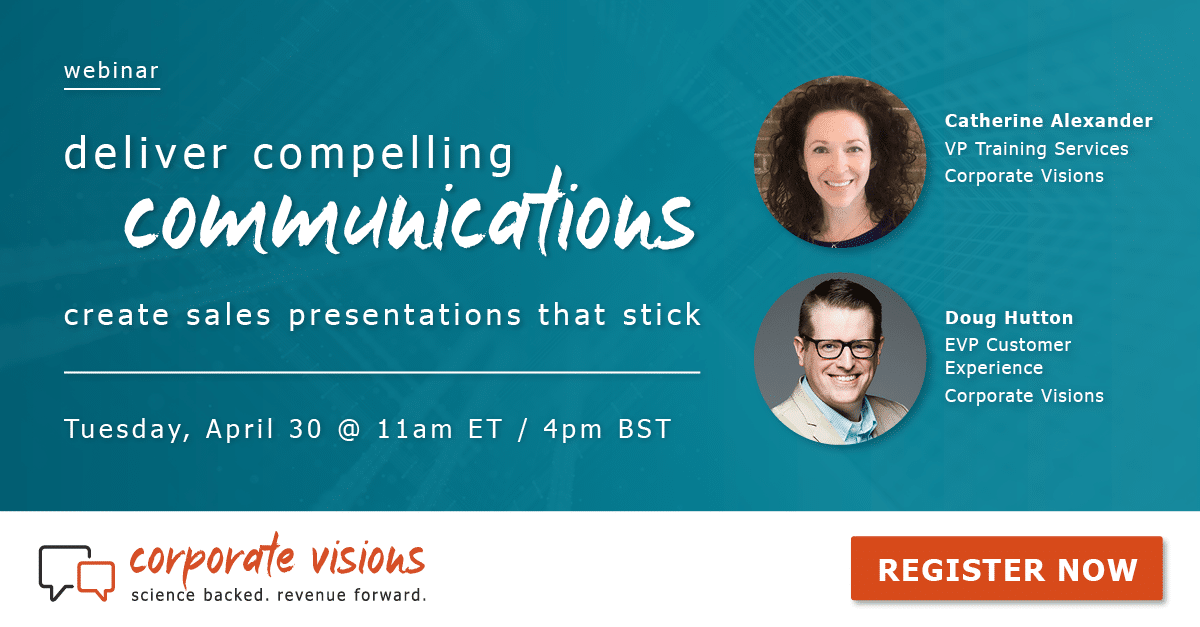
Dr. Carmen Simon
Chief Science Officer at Corporate Visions
Dr. Carmen Simon, Ph.D., is a Silicon Valley entrepreneur, cognitive neuroscientist, and renowned keynote speaker for sales and marketing audiences. Carmen offers a groundbreaking approach to creating memorable messages that are easy to process, hard to forget, and impossible to ignore―using the latest in brain science. Dr. Simon is the author of Impossible to Ignore: Creating Memorable Content to Influence Decisions.
The Path to Persuasion with Dr. Carmen Simon
A keynote series for senior leaders
The Science of Storytelling for Leaders
Every effective leader is an effective storyteller. But how do you know if you’re sharing stories that people will remember and act on them? Are all stories memorable and actionable? By now we know that the brain is “wired” for stories. We know the importance of setting, character, and action. And we realize that while bullet lists make communication efficient, it’s the emotion behind a story that counts. This is why we devour news, novels, and movies. We know all this. But there is so much more, as not all stories are created equal.
While we tout the “memorability” factor of stories, it is possible for the human brain to forget them. How many stories do you really remember from the past week? To become true leaders and influence others’ action, you must ask: what makes a story memorable? And what is the optimal amount of narrative to use when you speak about technical and complex content? After all, you want to be memorable and credible.
Join this interactive session to learn the latest brain science research on storytelling and how to apply it to your own leadership style to inspire and influence others.
The Neuroscience of Decision Making
Have you ever noticed a gap between what people say they will do and what they actually do after you talk to them? Lack of action and follow-through have negative consequences for the customer journey and business outcomes.
Using neuroscience, this session provides a unique approach to influencing and inspiring others to take action. During this interactive session, you learn how to:
- Connect three pathways to influencing others’ brains and understand how to approach people’s resistance to change
- Identify what your audiences’ brains find rewarding and appeal to these motivational drivers in your communication
- Use heuristics (mental shortcuts) to effortlessly influence your audiences’ actions in an effortless way
The Neuroscience of Embracing Change
Are you noticing that it is often difficult to adopt change in our companies, teams, and even our own lives? The primary obstacle to handling change is our brain, which is in constant conflict between indulging routines versus adopting something new.
Understanding change from the perspective of how the brain works is important because when we learn how to balance familiarity and novelty, change and innovation can happen quickly.
Upon completion of this course, participants will be able to:
- Use brain science principles to explain people’s resistance to change
- List three pathways to influencing others’ brains to adopt change
- Map business strategies to the three pathways in which the brain decides what to do next
The Neuroscience of Engagement
Everyone in business aspires to engage others at some point, internally or externally. In fact, engagement is so widely addressed that it’s becoming a big word that often means very little. So let’s define it meaningfully, using science. What does it really take for the brain to be engaged?
An intriguing approach to understanding engagement is to view it through its absence. What do we know about the psychology of boredom? Is it possible for the brain to be bored in the age of overstimulation? The answer is yes. As scientists, we used to believe that boredom was defined by the absence of stimulation. Now, we are discovering that too much stimulation can have a similar effect. So how do we prevent the brain from getting bored—therefore staying engaged with your message and your cause? The good news is that the brain does not want to stay bored for too long. From an evolutionary point, we cannot afford to stay bored.
In this keynote, you’ll learn four evidence-based, practical guidelines to use immediately to create meaningful engagement for your internal and external audiences.
Could a Robot Replace Your Sales Team?
We live in an era where algorithms rule. They are becoming increasingly more sophisticated and automate a lot of things in our lives, from buying books, to online dating, to travel. Will there be a point where the robot replaces your workforce? Can our humanity be automated?
It is helpful to strike a balance between robots and humans because it’s the human brain that creates demand, which keeps the economy strong, and it’s the machine that augments out human capabilities. During this keynote, Dr. Carmen Simon addresses from a neuroscience perspective how to balance the human and the machine and create loyalty and better engagement with your internal teams and clients.
Specifically, you will learn tangible and practical answers to these pressing business questions:
- Does the machine really have more power compared to humans?
- How can we help the machine and the human brain evolve together?
- How do we sustain our humanity in an engineered age?
The Four Habits of Highly Forgettable People
Being memorable is critical in business because customers make decisions in your favor based on what they remember, not on what they forget. Unfortunately, in business contexts, people are more forgettable than they are memorable. Using EEG (electroencephalogram) technology, we can detect what happens in the brain when it’s exposed to a business presentation, and during studies we conduct monthly with corporate teams, we observe that people retain less than 10% of business content after 48 hours.
Join this session to learn what it takes to keep your audiences’ brains engaged and likely to recall. Specifically, you will learn:
- The reasons why it is hard for audiences to remember business content
- The latest neuroscience insights into how the brain processes and remembers information
- The habits that lead to forgettable content, and how to avoid them
Priming the Brain for a Decision
A musician’s quote reminds us that “There is no such thing as a wrong note. It is always the note that follows that defines whether the first note is wrong or not.” The same goes for business content: there is no such thing as a bad slide, paragraph, or segment in a video or in a conversation. Each segment in a message has the potential to impact the next segment.
This is called priming. Join this session to figure out how to prime your audiences’ brains properly and lead them to a decision that serves them well. Specifically, in this session, you learn how to:
- Avoid the brain’s tendency to habituate to the segments in your content and offer it a jolt for focus and engagement
- Create more dramatic “signposts” in your messages and be deliberate about what the brain remembers and acts on
- Determine what to withhold, what to reveal to an audience, and in what order, so the brain reaches a decision effortlessly
The Neuroscience of Trust
Every organization is currently marked by change, and effective change requires trustworthy leadership. When people do not have much trust in those communicating change, any change initiative will fail. When trust is present, two variables that are important to any organizational change will be impacted: time and money. When trust is present, change will happen faster and at lower cost. When trust is absent, change will be slower and cost more. Join this interactive session to learn the four mandatory dimensions of trust that are critical to any change initiative.
The Neuroscience of Being Memorable
One of the biggest problems with business content is that customers forget 90% of what you share after 2 days. And the typical goal for creating a message and sharing it with a customer is to influence their behavior in some way. But how can they act on your message if they only remember a tenth of it? How do you even know which tenth they’ll remember?
Join this interactive session to discover strategies for transforming yourself and your message into something worth noticing and remembering. To help us understand how people pay attention, remember content, and ultimately act on it, we look at the field of neuroscience, which reveals insights on how the brain processes information and tends to remember it – or, more often – forget it. Join us to learn how to convert neuroscience insights into practical guidelines you can use to craft content with lasting impact. This is critical because both your internal and external audiences make decisions in your favor based on what they remember, not on what they forget.
Dr. Simon's Best-Selling Book
- Impossible to Ignore: Creating Memorable Content to Influence Decisions
The world’s leading organizations work with Corporate Visions to learn how to articulate value in your customer conversations
Trusted By






























